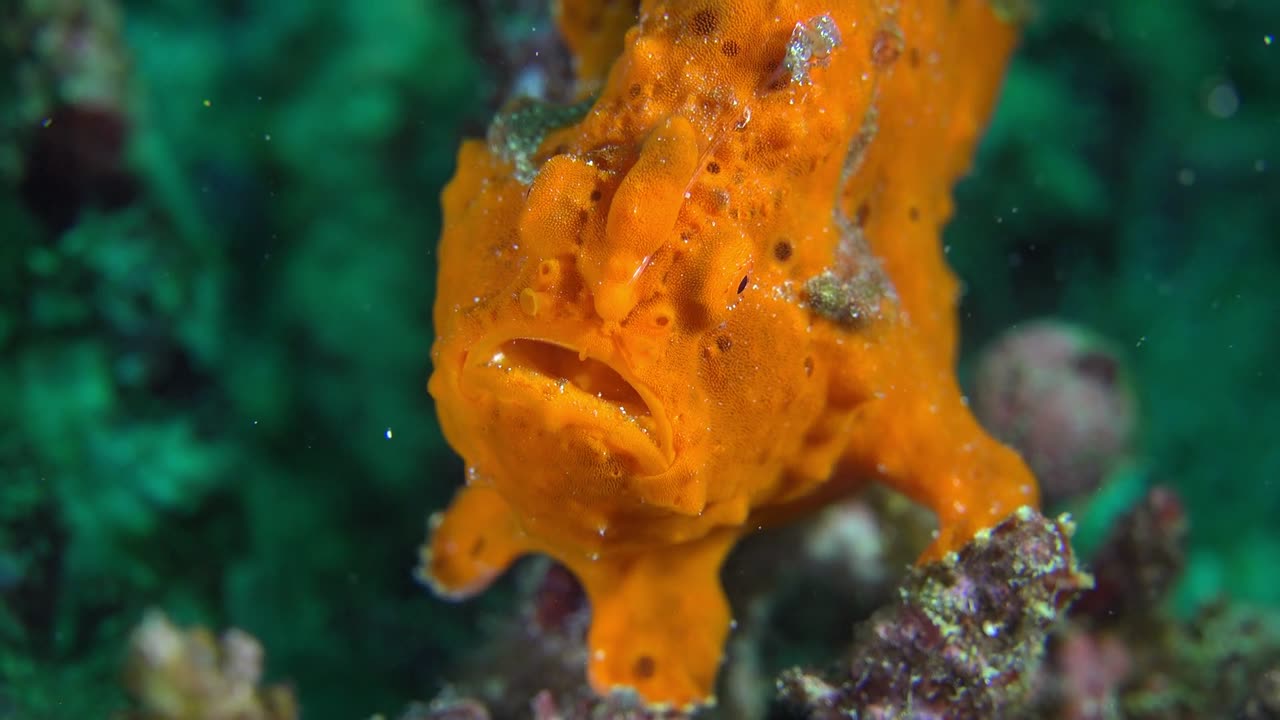Premium Only Content

Upclose with the Bizarre Orange FrogFish
The orange frogfish, scientifically known as Antennarius pictus, is a fascinating and peculiar marine creature found in the warm waters of the Indo-Pacific region. It belongs to the family Antennariidae and is renowned for its extraordinary appearance and unique hunting techniques. Here are some intriguing facts about the orange frogfish:
Camouflage Masters: Orange frogfish are masters of camouflage. They have a warty, textured skin covered in small protuberances and can change their color to match their surroundings, making them nearly invisible to both prey and predators. This incredible mimicry allows them to patiently wait for their prey, often resembling sponges or pieces of coral.
Bizarre Shape: These fish sport an unusual body shape characterized by a stocky, somewhat spherical body, and they have modified dorsal fins that resemble tiny "fishing rods" with a lure at the end. This lure is an elongated appendage that dangles in front of their mouth, attracting unsuspecting prey.
Slow Movers: Orange frogfish are not fast swimmers. Instead, they use their pectoral fins like legs to slowly "walk" along the seafloor or crawl on corals and sponges. This slow movement helps them maintain their cover and sneak up on prey.
Ambush Predators: These fish are ambush predators and have a voracious appetite. They typically feed on smaller fish, shrimp, and other small marine organisms. When prey comes within striking distance, the orange frogfish can lunge forward with astonishing speed, engulfing the unsuspecting victim in its large mouth.
Incredible Diversity: Frogfish, in general, come in a wide variety of colors and patterns, and the orange frogfish is just one of many unique species. They can be found in shades ranging from bright orange to mottled browns and whites, adapting to the specific habitats in which they live.
Solitary Creatures: Orange frogfish are typically solitary and don't interact much with other members of their species. They are often found in sandy or rubble areas, coral reefs, or on rocky substrates, blending seamlessly into their environment.
Reproduction: Little is known about the reproduction of orange frogfish. They release their eggs in a gelatinous mass, which floats near the surface. Once hatched, the tiny frogfish larvae disperse in ocean currents, undergoing a remarkable transformation as they grow into adults.
The orange frogfish's remarkable adaptation and appearance make it a sought-after subject for underwater photographers and a captivating sight for divers who venture into its natural habitat, adding a touch of wonder and mystery to the vibrant world beneath the ocean's surface.
-
 37:06
37:06
Camhigby
50 minutes agoI Was Stalked By DRONE At Dearborn MOSQUE
52 -
 12:38
12:38
Timcast
21 hours agoJasmine Crocket HUMILIATED By CNN To HER FACE Over Epstein LIE | Tim Pool
76.1K63 -
 19:32
19:32
MetatronHistory
18 hours agoWas Nazism Left Wing or Right Wing? An Answer From History
4.21K18 -
 LIVE
LIVE
a12cat34dog
2 hours agoI'M FINALLY BACK :: Resident Evil 4 (2023) :: FINISHING MAIN GAME & DLC {18+}
231 watching -
 31:23
31:23
Stephen Gardner
2 hours agoFINALLY! Charlie Kirk MISSING DETAILS released!
10K36 -
 5:26:11
5:26:11
cosmicvandenim
7 hours agoCOSMIC VAN DENIM | SEX APPEAL & HORROR
5.02K2 -
 LIVE
LIVE
DoldrumDan
2 hours agoFINISHING SEKIRO - DEPTH 5 TOP RANKED - DAY 50 NEW LIFE
47 watching -
 23:40
23:40
MYLUNCHBREAK CHANNEL PAGE
1 day agoWe Want the Blueprints
54K13 -
 LIVE
LIVE
PenguinSteve
4 hours agoLIVE! Penguin to the Battlefield (6)
55 watching -
 1:08:20
1:08:20
The Quartering
4 hours agoMTG Quits, Indian X Meltdown & FBI Caught Lying Again About Trump Assassin
131K71